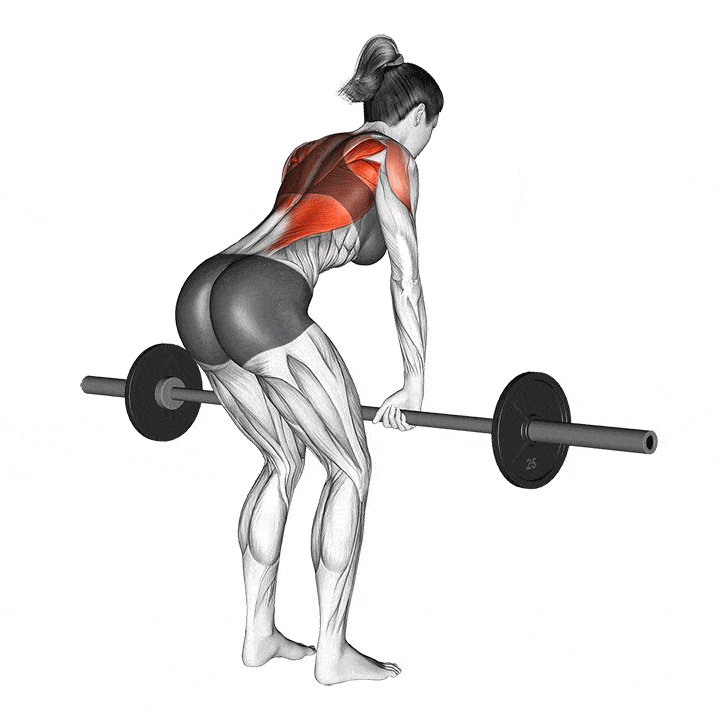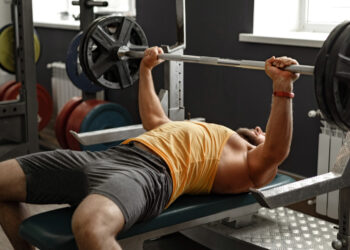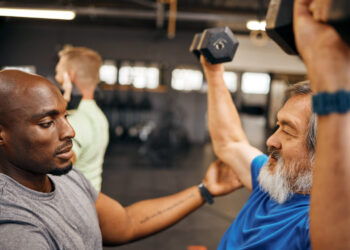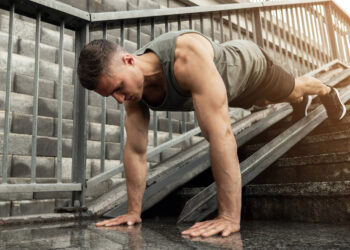Inverted rows, also known as Australian pull-ups and body rows, are a very effective calisthenic or bodyweight back and biceps exercise. Unlike pull-ups and chin-ups, inverted rows are done with your feet firmly planted on the floor, so you don’t have to lift your entire body weight with just your arms. This makes them ideal for beginners.
However, inverted rows are more than just an easier alternative to pull-ups and chin-ups; they’re a legitimate upper back exercise. You can use this exercise to build upper back thickness and also develop better posture. As an added benefit, you can also do inverted rows at home, so they’re the perfect excuse-free back exercise.
While we’ve got a lot of love for inverted rows, and they’re a hugely popular exercise, it’s important to understand that if you do them too often, they’ll gradually lose some of their potency. Your body adapts very quickly to the exercises in your workout, which is why it’s important to change your program every 6-8 weeks. If you continue doing the same workout for too long, your progress will stall, and you’ll end up in a training rut.
So, while inverted rows are a good (if not great!) back builder, every smart exerciser needs to know plenty of alternatives so they can keep their workouts fresh and productive (1).
In this article, we reveal the 12 best alternatives to bodyweight inverted rows.
12 Top Inverted Row Substitutes & Alternatives
Whether you’re bored of inverted rows, can’t find somewhere to do them, or just don’t like this exercise very much, there are lots of other ways to strengthen your upper back.
Level Up Your Fitness: Join our 💪 strong community in Fitness Volt Newsletter. Get daily inspiration, expert-backed workouts, nutrition tips, the latest in strength sports, and the support you need to reach your goals. Subscribe for free!
Here are 12 of the best inverted row alternatives:
1. Bent-over Barbell Row
Bent-over barbell rows are a controversial bodybuilding exercise. Back in the golden era of bodybuilding, they were seen as an effective mass builder. Nowadays, a lot of trainers view them as dangerous and outdated. The truth is that, providing you do them correctly and do NOT round your lower back, bent over rows are a great way to build your back. Most exercisers should be able to do them safely.

How to do:
- Stand with feet shoulder-width apart and hold a barbell with an overhand grip.
- Bend the knees slightly and lean forward from your waist.
- Keep your back straight and pull the barbell towards your lower rib cage.
- Slowly lower the barbell back down.
Coaching Tip: Ensure your back remains flat throughout the movement. Avoid rounding your shoulders.
Learn more about bent-over rows here.
2. Pendlay Row
Pendlay rows are named after USA weightlifting and powerlifting coach Glen Pendlay. Also known as a dead stop row, this exercise involves resting your barbell on the floor between reps.
This gives your lower back and grip a brief rest, so you should be able to use more weight compared to regular barbell bent-over rows. They’re also a little more back-friendly than regular bent-over barbell rows.
How to do:
- Begin in a bent-over position similar to the bent-over barbell row.
- The barbell starts on the ground each rep.
- Pull the barbell explosively to the lower rib cage, then lower it back to the ground.
Coaching Tip: This exercise focuses on explosive strength. Ensure the bar touches the ground after each rep.
Find more on Pendlay rows here.
3. Yates Row
Six-time Mr. Olympia winner Dorian “The Shadow” Yates had one of the best backs in bodybuilding history. Like most bodybuilders, Yates used a variety of exercises to sculpt his back. However, he attributes at least some of his back-building success to this variation of bent-over rows, which has since been called the Yates row.
Yates rows are done with less forward lean than regular bent-over rows, making them easier on your lower back.
How to do:
- It’s similar to the bent-over row, but with an underhand grip.
- Keep the torso more upright.
Coaching Tip: The underhand grip can put more emphasis on the biceps. Make sure to squeeze your shoulder blades together at the top.
Discover more about Yates rows here.
4. T-bar Row
T-bar rows are something of a bodybuilding staple. A little less stressful for your lower back than regular bent-over rows, most gyms have a T-bar row machine. You can also do T-bar rows using a device called a landmine or just wedging the end of a barbell into a corner. T-bars rows are an excellent back builder.
How to do:
- Stand over a T-bar row machine and grip the handles.
- Keep the back straight and pull the weight towards you, squeezing your shoulder blades together.
Coaching Tip: Make sure you’re lifting with your back muscles and not just your arms.
Learn more about T-bar rows here.
5. Single-Arm Dumbbell Row
While all types of barbell rows are effective exercises, they all involve unsupported forward flexion, which puts a lot of stress on your lower back. Lack of lower back strength could bring your set to a premature end, making your workout less effective.
Single-arm dumbbell rows leave you with one hand free, so you can support your upper body and focus all your efforts on working the target muscles as hard as you like. Single-arm rows are also very lower back-friendly, making them a good choice if you suffer from back pain.
How to do:
- Place one knee and one hand on a bench, holding a dumbbell in the free hand.
- Row the dumbbell up to your hip, keeping your elbow close to the body.
Coaching Tip: Ensure your spine remains neutral and avoid twisting your torso.
Find out more about single-arm dumbbell rows here.
6. Kroc Row
Kroc rows are a variation of single-arm dumbbell rows. Named after bodybuilder and powerlifter Mathew Kroczaleski, who after gender reassignment is called Janae Marie Kroc, this exercise involves lifting heavy weights for high reps to build both muscle size and strength.
Kroc rows use your legs and lower back to help lift the weight. While some view this as cheating, it’s cheating with a purpose and helped Kroc build an impressively strong and muscular back.
How to do:
- It’s a heavy dumbbell row performed for higher reps.
- Use a loose form but ensure the range of motion is full.
Coaching Tip: This exercise is about building grip and back strength. Choose a weight that’s challenging but safe.
Learn more about Kroc rows here.
7. Renegade Row
Renegade rows are a very functional back exercise. Not only do they work your lats, mid-traps, posterior deltoids, and biceps, they engage your core too. Add a push-up between reps, and you’ve got a complete upper body workout in a single exercise. Start with light weights; this move is harder than it sounds!
Level Up Your Fitness: Join our 💪 strong community in Fitness Volt Newsletter. Get daily inspiration, expert-backed workouts, nutrition tips, the latest in strength sports, and the support you need to reach your goals. Subscribe for free!
How to do:
- Start in a plank position holding dumbbells.
- Row one dumbbell to the hip while balancing on the other, then switch.
Coaching Tip: Keep your core tight to prevent your hips from swaying.
Find out how to do renegade rows here.
8. 3-point Plank Row
The 3-point plank row is another back exercise that also provides your core with a demanding workout. However, for this variation, you’ll be working one arm at a time, making it better for overloading your lats. Do this exercise with a single dumbbell or kettlebell as preferred.
How to do it:
- Place one hand on a bench and then walk your feet back, so your body is straight. Brace your core.
- Holding a single dumbbell or kettlebell, row the weight up and into your lower ribs. Keep your hips and shoulders square.
- Extend your arm and repeat.
- Rest a moment, and then do the same number of reps on the opposite side.
Coaching Tip: This version provides more stability. Make sure your hips are square to the ground.
9. Wrestler’s Row
While we don’t know why this exercise is called the wrestler’s row, there is no denying its effectiveness. It’s a useful exercise if you only have light dumbbells to train with. Your muscles are kept under constant tension, which is what makes this exercise so challenging.
How to do it:
- Hold a dumbbell or kettlebell in each and stand with your feet shoulder-width apart. Bend your knees slightly and then lean forward, so your torso is inclined to about 45 degrees. Pull the weights up and into your ribs. This is your starting position.
- Keeping one arm stationary, lower the other weight down to arms’ length and then row it back in again.
- Repeat on the opposite side.
- Continue alternating arms for the duration of your set, keeping one arm pulled up and in at all times.
Coaching Tip: Engage your core and glutes for stability.
10. Chest-Supported Row
Most rowing exercises put at least a little stress on your lower back. This one is different because you’ll be fully supported by a bench, leaving you free to focus on working your lats, traps, etc. You can do this exercise using a barbell, dumbbells, or kettlebells.
How to do it:
- Place a flat bench on blocks or stacked weight plates, making sure it’s stable. Lie face down on the bench with your arms hanging straight down. Hold your barbell or dumbbells. Pull your shoulders down and back.
- Bend your arms and, leading with your elbows and keeping your wrists straight, pull the weight up to the side of your chest.
- Extend your arms and repeat.
Coaching Tip: This exercise reduces the risk of using momentum. Focus on the squeeze at the top.
11. Seated Cable Row
Seated cable rows are one of the most lower back-friendly unsupported rowing exercises. That said, if you use too much body English, you could still hurt your back doing them. Avoid injuries by sitting up straight, bracing your abs, and not leaning forward or backward while doing this exercise. If you DO lean forward, make sure the movement comes from your hips and not your lumbar spine.
How to do:
- Sit down at a cable row machine, feet on the platform.
- Pull the handle towards you, squeezing the shoulder blades.
Coaching Tip: Keep your spine straight and avoid leaning back as you pull.
Learn more on seated cable rows here.
12. Face Pulls
If you use a wide grip and pull your chest up to the bar instead of your abs, inverted rows are a very effective postural exercise, as they emphasize your mid-traps, rhomboids, and posterior deltoids more than your lats.
Face pulls are an even more effective postural exercise. Use a rope handle to maximize your range of motion for an even better upper back workout.
How to do:
- Using a rope attachment on a cable machine, pull the rope towards your face, separating the two ends as you pull.
Coaching Tip: Focus on pulling with the rear delts and upper traps, not just the arms.
Discover more about face pulls here.
Inverted Row Anatomy
Inverted rows are a compound back exercise. To be considered a good alternative, whatever exercises you do instead must work the same muscles, albeit using different training apparatus or a slightly different movement. The primary muscles involved in inverted rows are:
Latissimus dorsi
Called the lats for short, these muscles are located on the side of your upper back. Their main function is adduction and extension of the shoulder joint. Well-developed lats look like wings, and they’re visible from the front and the rear.
Trapezius
Located across your upper back, the trapezius or traps is a large, diamond-shaped muscle. There are three sets of trap fibers; upper, middle, and lower. The upper traps elevate your shoulders, while the lower traps pull your shoulders down. The middle fibers of the trapezius, usually called mid-traps, are responsible for pulling your shoulders back and together. The mid-traps are the most active during inverted rows.
Rhomboids
The rhomboids work with your mid-traps to pull your shoulders back and together. They’re located beneath the traps and are between your scapulae or shoulder blades.
Posterior deltoids
The posterior deltoids are your rearmost shoulder muscle. Their primary function is the extension of the shoulder joint. The posterior delts are also an important postural muscle. Pulling your chest to the bar, as opposed to your abdomen, increases posterior deltoid engagement.
Biceps
Located on the front of your upper arm, the biceps flex your elbows during inverted rows. Using a supinated or underhand grip increases biceps engagement.
Posterior chain
To do inverted rows correctly, you need to keep your body straight. This action uses your posterior chain, which is the collective term for your gluteus maximus, hamstrings, and erector spinae. However, the load on these muscles is relatively low.
Core
Core is the collective term for the muscles of your midsection, including the rectus abdominis, obliques, and transverse abdominis. These muscles contract inward to create intra-abdominal pressure or IAP to stabilize your lumbar spine. As with the posterior chain, the core isn’t under a lot of tension during inverted rows.
Inverted Row Alternatives – Wrapping Up
Body rows are a great back builder, but it would be a mistake to do them all the time. Keep your workouts productive by using these twelve inverted row alternatives from time to time. Each one works the same muscles but is different enough to keep you out of those dreaded muscle-building ruts.
That’s not to say you need to give up inverted rows for good, but even a one-month break will mean that, when you add them back into your workouts, they’ll be productive again.
Remember, for building muscle, variety is just as important as the weights you left and the rep range you use (1).
References:
1 – PubMed: Changes in exercises are more effective than in loading schemes to improve muscle strength https://www.ncbi.nlm.nih.gov/pubmed/24832974
Interested in measuring your progress? Check out our strength standards for Face Pull, Pendlay Row, Pull Ups, and more.











